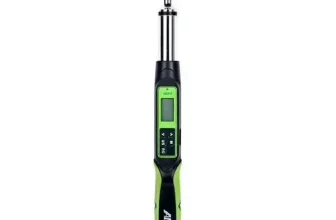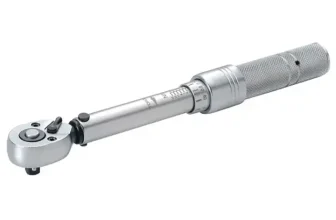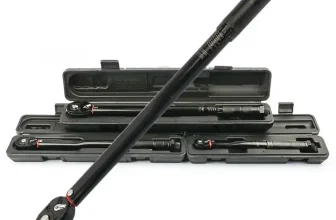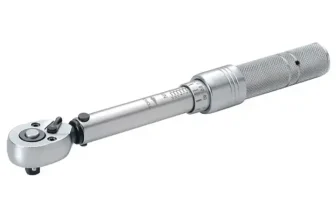A Spanner Torque Wrench is a specialized tool essential for a diverse
number of industries, including manufacturing, automotive, home repair,
and more. This unique tool possesses the amalgamation of a conventional
spanner’s design and the functionality of a torque wrench. Unlike
standard wrenches that only provide force, a Spanner Torque Wrench
affords control over the amount of torque or turning force applied to
nuts or bolts. This feature guarantees precise and safe fastening or
loosening of mechanical components without causing damages or meeting
unfortunate accidents. Equipped with a calibrated scale, it enables
users to ensure proper tightening pressure, thereby extending the
lifespan of mechanical units and enhancing safety on the job.
Importance and
uses of Spanner Torque Wrench
The importance and uses of a Spanner Torque Wrench stretch far and
wide, especially when factoring in its vital role in numerous
industries. This includes automotive, construction, manufacturing, and
even in the realm of DIY home projects. This tool’s main use is to
measure and apply a specific torque to a fastener such as a bolt or a
nut, which results in an accurate and secure fit.
Understanding and applying the correct amount of torque is essential
to the integrity and performance of the assembly. Whether it is securing
a cylinder head in an automobile, fastening bridge sections, or even
assembling a piece of furniture, the Spanner Torque Wrench ensures the
necessary precision and reliability. This helps to avoid structural
failures, threaded fastener problems, or hazardous situations that can
arise from incorrect fastening. Hence, a Spanner Torque Wrench has an
irreplaceable role in ensuring secure and safe assembly in many
applications.
Understanding Spanner
Torque Wrench
Definition and
features of Spanner Torque Wrench
A Spanner Torque Wrench, as the name suggests, is a specialized tool
that combines the utility of a spanner with the precision of a torque
wrench. This tool is designed specifically to apply a specific amount of
torque, or turning force, to a nut or bolt. The main purpose is to
ensure that the nuts and bolts are neither too loose nor too tight but
are fixed just right, as per the recommended specifications.
One of the distinctive features of a Spanner Torque Wrench is its
‘torque adjustment’ mechanism. This mechanism allows the user to set the
desired level of torque that needs to be applied to the nut or bolt.
Once the set level of torque is reached, the wrench typically produces a
‘click’ sound, or gives a physical jerk as a signal to stop applying
further force. This prevents over-tightening and potential damage to the
parts.
Furthermore, Spanner Torque Wrenches are also praised for their
flexibility. They typically come with a ratcheting mechanism which
allows the user to tighten or loosen nuts and bolts without removing and
repositioning the wrench on the fastener.
Lastly, Spanner Torque Wrenches are usually constructed from sturdy
materials like hardened steel that can withstand high levels of torque
and prolonged utilization. They are designed to deliver precise readings
and can be trusted for maintaining standards in different assembly and
repair tasks.
Different types of
Spanner Torque Wrench
Adjustable Spanner Torque
Wrenches
Adjustable Spanner Torque Wrenches are a versatile subset of torque
wrenches. These tools incorporate an adjustable head, allowing for the
adjustment of the tool to suit various sizes of nuts and bolts. This
eliminates the need for multiple wrenches of different sizes for
different tasks, making them a cost-effective option for both
professional tool kits and home workshops.
They’re designed with a dynamic torque adjustment mechanism which
allows for variable force to be applied depending on the requirements of
the specific fastener being worked on. A scale and a firm locking system
is usually integrated into the handle of the wrench. The scale is used
to set the required torque level accurately, after which the lock
ensures the set torque is maintained during use, reducing the
possibility of under or over-tightening.
One of their major advantages is that they adapt well to a variety of
tasks. They can handle a wide range of fastener sizes, making them well
suited for jobs that involve numerous different-sized bolts and
fasteners. This adaptability makes adjustable spanner torque wrenches an
essential component in many industrial sectors such as automotive,
aerospace, construction and heavy machinery repair and assembly.
Preset Spanner Torque
Wrenches
A Preset Spanner Torque Wrench is a specialized variant designed to
apply a particular torque level that is pre-set by the manufacturer.
These wrenches are highly suitable for operations that require
consistent torque values, minimizing the risk of human error during the
tightening process.
Ideal for commercial and manufacturing setups where consistency is
imperative, these wrenches literally click to let you know when the
preset torque value has been achieved, preventing over-tightening. They
are typically non-adjustable, making them preferable for applications
with specific torque requirements.
While working with sensitive components, preset spanner torque
wrenches instill confidence, ensuring the desired torque is applied
every time without fail. This uniformity brought in by these wrenches
makes the assembly process more streamlined and efficient. Especially
prevalent in automotive, aircraft production lines, or spaces where
precision and repetition are essential, these wrenches govern a wide
array of industrial processes.
How Spanner Torque Wrench
works
The functioning of a Spanner Torque Wrench is fairly straightforward
and relies on its unique design and certain basic principles of
physics.
Inside the wrench, there’s a calibrated spring mechanism. The user
selects the required amount of torque (the rotational force to be
applied) by adjusting the handle. This setting compresses or releases
the internal spring according to the user’s desire.
When you start tightening a bolt with the tool, the main shaft of the
wrench begins to twist slightly as more pressure is applied. This twist
increases until the desired torque, set by the user, is reached. At this
point, the wrench’s handle will produce a distinct click sound,
signalling the user to stop applying any more force. This “click”
mechanism helps to avoid over-tightening, reducing the risk of damage to
materials or components.
The internal mechanics of the wrench make sure that no matter how
much additional force you apply, the turning force (torque) will not
increase beyond the set level. This saves the bolt or nut from any
potential wear and tear or breakage caused by excessive force.
Specific
uses and applications of Spanner Torque Wrenches
Spanner Torque Wrenches are an integral tool in a wide range of
industries. One of their most common uses is in the automotive sector,
where they facilitate the assembly and repair of vehicles. By providing
the precise amount of torque, they ensure that the components of the
vehicle are properly tightened, vastly lowering the risk of parts
loosening unexpectedly during operation.
In the realm of construction, these tools are utilized to secure
structural elements like bolts and nuts in buildings, bridges, and other
infrastructure. This aptitude to apply a specific level of torque is
crucial in ensuring the safety and longevity of these structures.
Furthermore, they are also found in the domain of manufacturing and
assembly lines, especially in precision industries such as aerospace and
electronics. In these environments, where over-tightening of screws,
bolts, and other fasteners can result in damage to sensitive components,
the torque control offered by these spanner wrenches is invaluable.
Beyond these industrial applications, spanner torque wrenches are
also common in residential settings. They are often used for routine
home maintenance tasks, such as assembling furniture and working on home
appliances, where they offer the benefit of preventing damage that could
result from over-tightening.
In short, the spanner torque wrench is a versatile tool, with
applications ranging from the factory floor to the garage, making it an
indispensable choice for professionals and homeowners alike.
Benefits of Spanner Torque
Wrench
Precise tightening of
bolts and nuts
A key benefit of using a spanner torque wrench is the precision it
provides when tightening bolts and nuts. Without such a tool, it is
risky to depend solely on human judgment for tightness as it can lead to
over- or under-tightening, both of which have potential drawbacks.
Over-tightening can stress or damage the threads and under-tightening
can cause the joint to loosen over time, consequently leading to the
failure of a component or an entire system.
In contrast, a Spanner Torque Wrench measures the level of torque or
turning force that is applied, thereby allowing a bolt or nut to be
tightened to the exact specifications. This precision is particularly
important in various industrial and mechanical settings, as well as in
the automotive world, where bolts and nuts must occasionally be
tightened to an exact force to ensure proper assembly and secure
fitting.
By delivering the precise level of tightness, the spanner torque
wrench ensures proper functioning and longevity of the equipment while
also preventing the potential dangers associated with over- or
under-tightening. Thus, it’s a vital tool for maintaining the integrity
and safety of various mechanical systems.
Improving efficiency
and quality of work
Spanner Torque Wrenches are designed to significantly enhance both
efficiency and the quality of work in numerous applications. The
precision in control they offer reduces the time spent on repairing or
redoing tasks, thus expediting the overall process.
For professions that require consistency in tightening components
such as automotive jobs, aerospace engineering, and manufacturing, these
tools are crucial. They can ensure uniformity even in a production line
setting, where maintaining the same degree of tightness or looseness
across all assembled parts is essential for optimal product
performance.
In other words, the use of a Spanner Torque Wrench guarantees that an
individual or a team can perform tasks flawlessly the first time around,
thereby saving both time and resources. It ensures that the tasks are
carried out correctly and efficiently, which can lead to a higher
quality output. The improved efficiency and quality of work also instill
confidence in clients who can trust the expertise and precision
associated with the services offered.
Prevention
of over-tightening and under-tightening
One of the major benefits of using a spanner torque wrench is the
prevention of over-tightening and under-tightening. Fasteners that are
under-tightened can lead to loose assemblies and equipment failures. On
the other hand, over-tightening can cause stress and tension on the
fasteners, eventually leading to stripping or breaking of bolts and
nuts.
Fortunately, a spanner torque wrench helps to mitigate these
potential issues. It’s specifically designed to apply a specific amount
of torque to a fastener, ensuring that it’s neither too tight nor too
loose. The user sets the desired level of torque and the wrench delivers
an accurate and consistent amount of force. This keeps the fastener
secure, and extends the lifespan of both the tool and the assembly it’s
fastening, avoiding potential damage and maintaining the integrity of
the joint.
So, with a spanner torque wrench, you have control over the
tightening process, promoting reliability and safety in your mechanical
designs, assemblies, and infrastructural projects.
Ensuring safety
One of the key benefits of using a Spanner Torque Wrench is its role
in ensuring safety at work. Incorrect torque application, particularly
with critical fasteners, can lead to hazardous situations, including the
loosening of nuts and bolts or their extreme tightening causing breakage
or equipment failure. These issues can create unsafe conditions, leading
to accidents or damage.
A Spanner Torque Wrench provides a precise torque measurement which
helps assure that all fasteners are tightened to their specified torque,
eliminating dangers associated with over or under tightening. This
feature considerably reduces the potential risk of component failure,
thereby ensuring a safer working environment. Professional mechanics,
builders, and DIY enthusiasts all agree that this accuracy is pivotal
when it comes to preventive maintenance and safety. The ability to
tighten fasteners accurately and within specifications makes the Spanner
Torque Wrench a valuable tool in any safety-conscious individual’s
toolkit.
Choosing the Right
Spanner Torque Wrench
Considerations
when buying a Spanner Torque Wrench
Size and weight
When choosing the right Spanner Torque Wrench, one of the first
considerations should be size and weight. The size of the wrench should
be compatible with the size of the bolts and nuts you will be working
on. Wrenches that are too large or too small can risk damage to the
tools and workpieces, or can make work needlessly difficult.
Weight might not seem like a crucial factor at first, but remember
you’ll likely be handling this tool for extended periods. A tool that is
too heavy can lead to fatigue and even long-term strain. Conversely, a
wrench that is too light may not allow for the necessary force for your
task.
A good rule of thumb is to choose a spanner torque wrench that feels
comfortable and well-balanced in your hand. Being comfortable with your
tool will contribute to better accuracy and efficiency on the job. The
right size and weight can also reduce the risk of injury that can occur
from using a tool that is ill-suited to the user. It’s about finding
that sweet spot between comfort and functionality for your specific
needs.
Torque range
The torque range is an essential factor to consider when purchasing a
Spanner Torque Wrench as it defines the extent of force the wrench can
apply. This is typically measured in foot-pounds (ft-lb) or
Newton-meters (Nm).
If you’re seeking a torque wrench for light tasks, such as work on
bicycles, motorcycles, or small appliances, a Spanner Torque Wrench with
a low torque range may be sufficient. Such wrenches can seamlessly
handle torque settings in the range of 20 to 200 inch-pounds (in-lb) or
the metric equivalent.
On the other hand, if your intended use is for automotive tasks or
larger industrial tasks, you would need a tool with a higher torque
range, typically between 50 to 250 ft-lb or more. These wrenches are
designed for heavy-duty tasks, such as tightening lug nuts or heavy
machinery bolts.
The torque range will determine whether a particular Spanner Torque
Wrench is the right fit for your requirements. Always remember to choose
a wrench that has a torque range suitable for the tasks you regularly
perform.
Material and durability
When deciding to buy a Spanner Torque Wrench, considerations around
the material and durability of the tool are of utmost importance.
These tools are often used in demanding environments and for
heavy-duty tasks, so they need to be robust and hard-wearing. The most
durable Spanner Torque Wrenches are typically made out of high-grade
steel or chrome vanadium, materials known for their strength and
resilience. These materials are resistant to rust and corrosion,
ensuring the longevity of the tool.
Another factor to keep in mind is the finish of the wrench. A good
quality finish not only enhances the aesthetic appeal of the tool but
also contributes to its durability. A polished or chrome-plated finish
can provide an additional layer of protection against wear and tear.
It’s also important to check the construction of the wrench. Look for
Spanner Torque Wrenches with a robust and sturdy construction. They
should feel solid and substantial in your hand, providing a clear
indication of their durability. If the wrench has any moving parts, they
should operate smoothly with no signs of looseness.
In conclusion, considering the material and durability of a Spanner
Torque Wrench is a vital step when investing in a tool that can
efficiently meet your needs while lasting for years to come.
Top brands of
Spanner Torque Wrench in the market
The market hosts an array of esteemed brands that manufacture
top-notch spanner torque wrenches. Having a grip on the notable ones can
help you make an informed purchasing decision.
Snap-On Industrial Brands, for instance, is globally recognized for
their robust and reliable spanner torque wrenches. They are highly
favored due to their ethos of innovation, ensuring that their tools are
always ahead of the curve when it comes to the latest technological
advancements.
Beta Tools is another exemplary brand known for their rich history of
creating high-quality spanner torque wrenches. Founded in Italy, their
offerings are curated with the meticulous precision that Italian
craftsmanship is known for.
Next on the list is Gedore. This German-based brand has established a
reputation for superior tooling options that deliver a blend of
precision, durability, and ease-of-use, making it a go-to choice for
professional mechanics and DIY enthusiasts alike.
Craftsman, an American company, is loved by many for its versatile
tools that are budget-friendly without compromising on performance and
durability. Known for their warranty promises, they ensure the spanner
torque wrench you invest in is built to last.
Last but not least, Norbar is a UK-based company that’s a global
leader in manufacturing of torque wrenches. They are esteemed for their
vast range of options, each meticulously designed and rigorously tested
to ensure superior performance.
These five brands serve as starting points when shopping for a
spanner torque wrench. Each brand has its unique qualities, thus it
boils down to your personal preference, budget, and specific needs.
How to use and
maintain a Spanner Torque Wrench
Step-by-step
guide on how to use a Spanner Torque Wrench
Using a Spanner Torque Wrench properly will not only ensure that your
work is done accurately but also extend the lifespan of your tool. Here
is a simple step-by-step guide to help you get started:
-
Identify the correct size: Before you begin, ensure you have the
appropriate spanner torque wrench for your job. This tool is designed
for specific bolt and nut sizes, so using the correct one is crucial for
accuracy. -
Set the desired torque: If you’re using an adjustable spanner
torque wrench, you’ll need to manually set the torque. This is typically
done by turning a knob or dial on the handle of the wrench until it
aligns with the desired torque value. -
Apply the wrench: Place the wrench on the bolt or nut you need to
tighten. The wrench should fit snugly and securely. -
Apply force: Begin tightening the bolt or nut by applying a
steady force on the handle of the wrench. Use a smooth and steady
motion; do not yank or excessively force the wrench. -
Listen for the click: Most spanner torque wrenches make a
distinct click sound when the preset torque value is reached. If your
wrench makes this sound, stop applying force immediately. This indicates
that you have tightened your bolt or nut to the desired torque. -
Release and reapply: After every successful tightening, release
the torque wrench and reapply it for the next one. Do not forget to
reset the torque if it varies for the next bolt or nut. -
Return to zero: When you have completed your task, always
remember to return the adjustable wrench to its lowest setting or
‘zero’. This helps maintain the calibration and prolongs the lifespan of
your tool.
Remember, always refer to the user manual provided by the
manufacturer as some models might have specific usage instructions.
Practice proper safety measures and equipment handling while using any
tool.
Tips
for maintaining and calibrating a Spanner Torque Wrench
To keep your Spanner Torque Wrench in optimal condition, some routine
maintenance and calibration steps should be followed regularly:
-
Store Properly: Always store the wrench in a dry and clean
toolbox or cabinet. This helps protect it from dust, humidity, and other
potentially damaging conditions. -
Avoid Overloading: Never use the wrench beyond its maximum
capacity. This can cause wear, tear, and potential damage to the
tool. -
Regular Cleaning: Regularly clean the wrench using a soft, dry
cloth. Avoid using harsh chemicals or abrasives that might damage the
wrench’s surface. -
Periodic Calibration: It is crucial to get your wrench calibrated
periodically by a professional. This ensures that it delivers the
correct amount of torque force. The frequency of recalibration typically
depends on how frequently the wrench is used, but a general rule of
thumb is to calibrate it after every 5000 uses or at least once a
year. -
Lubrication: Occasionally lubricate the moving parts of the
wrench, such as the ratcheting mechanism, using a light machine oil.
This helps reduce friction and prevents wear and tear. -
Check for Wear and Tear: Regularly inspect your wrench for any
signs of damage or wear. If any part of your wrench is worn out, replace
it as soon as possible to maintain its efficiency and accuracy.
By following these maintenance and calibration tips, your Spanner
Torque Wrench will continue to function effectively, ensuring accuracy
and efficiency in your work. Remember, proper care and maintenance will
extend the lifespan of your wrench and save you from unnecessary costs
or accidents.
Conclusion
Recapitulation
of the importance and benefits of Spanner Torque Wrench
Spanner Torque Wrenches have consistently proven to be a crucial tool
in various industries, from automotive repair to construction and
beyond. Its primary function, the precise tightening of bolts and nuts,
is invaluable in ensuring the integrity and longevity of any mechanical
set-up. By allowing for exact torque application, it effectively
mitigates the risk of over-tightening or under-tightening, thereby
significantly improving the efficiency and quality of work.
The safety provision of these tools cannot be overstated, as it not
only prevents potential damage to the assembly but can additionally
guard against injuries resulting from tool slippage or bolt breakage.
With the variety of spanner torque wrenches available in the market,
users have the flexibility to pick a tool that best suits their size,
weight, and torque range requirements, thereby further increasing
productivity.
Moreover, its easy maintenance and calibration process ensure that
the tool remains highly efficient and durable, serving as a trusted
companion to any mechanic or handyman for a long time.
We hope that this article has shed light on the remarkable utility of
Spanner Torque Wrenches and encourages you to harness their potential to
the fullest. Remember, using the right tools in the right way can build
the path to successful project completion.
Final
thoughts and encouragement for appropriate tool usage
Spanner Torque Wrenches, with their precision and easy regulation of
the force applied, are indispensable tools in many fields, ranging from
automobile mechanics to aerospace technology. Their convenience,
efficacy, and safety features grant them a special place in every
toolbox.
In order to derive the utmost benefit from a Spanner Torque Wrench,
it is crucial to choose the right type that fits your specific needs,
know how to use it correctly, and take measures to maintain and
calibrate it properly. Regardless of the nature of the task – whether
it’s an everyday household repair, a car fix, or a complex industrial
assembly – a Spanner Torque Wrench can significantly simplify your work,
prevent damage to parts, and keep you safe.
Just remember, every tool requires the skill of a craftsman to make
the best use of it. Hence, spend time understanding the tool, its
features, its do’s and don’ts, and practice using it before you apply it
in real projects or repairs; thus making sure you are proficient and
confident in its usage. And as always, safety should never be
compromised. So, always wear suitable protective gear and work in an
environment that is clean and free from potential hazards.
In conclusion, the Spanner Torque Wrench, when used correctly and
regularly maintained, is indeed a noteworthy companion in numerous tasks
which demand precision and safety.







